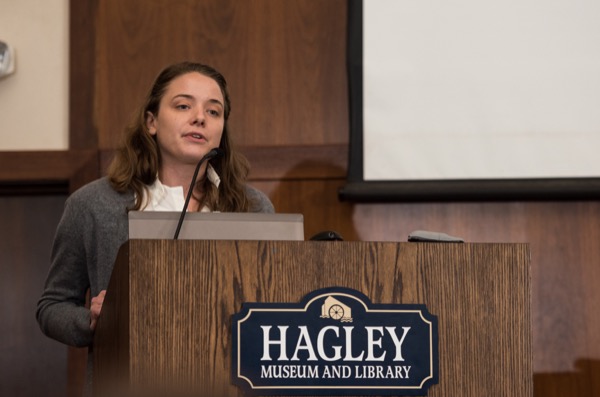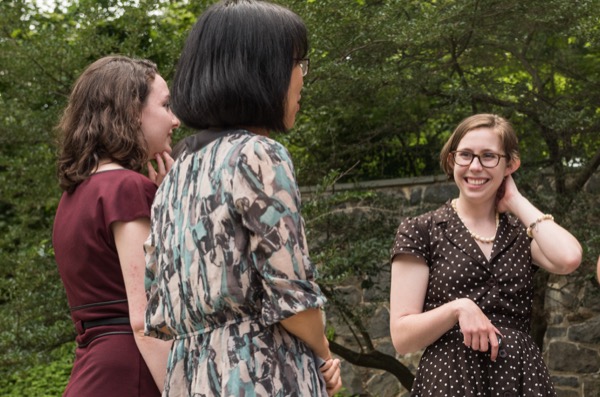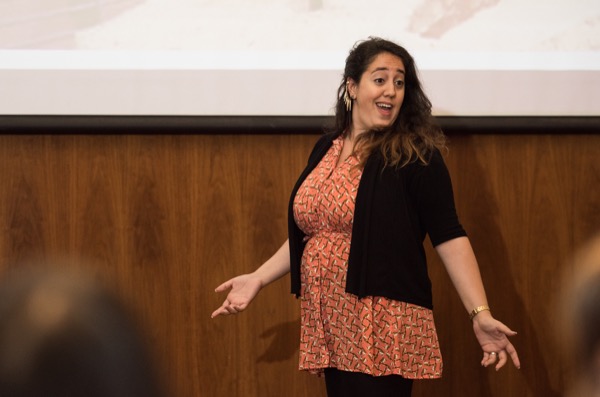


Engaging humanities
Summer humanities institute prepares graduate students for public outreach
2:32 p.m., June 22, 2015--If research in the humanities is sometimes misunderstood or undervalued by the public, it won’t be the fault of a group of graduate students who attended an intensive institute at the University of Delaware this month to learn how to share their scholarly passions.
Participants in the Delaware Public Humanities Institute (DelPHI) devoted two weeks to learning, developing and practicing an assortment of techniques for engaging a variety of audiences in their work. Focusing on everyone from children in elementary school to residents of retirement communities, the students came up with creative ways to reach out.
Campus Stories
From graduates, faculty
Doctoral hooding
Sessions covered such topics as social media, public relations, marketing, grant-writing and copyright law. The students took part in workshops in which they developed websites and learned to make iMovies showcasing their research, and they got tips for being interviewed by journalists in sessions that were video-recorded for follow-up critiques.
In the last afternoon of the institute, the group gathered in an auditorium at Hagley Museum and Library near Wilmington, Delaware, for final presentations. Each student had been randomly assigned a type of audience for which to develop a 10-minute talk describing his or her research and its importance.
With a lectern, microphone and screen on which to project PowerPoint slides, each student spoke to the other institute participants, who role-played the different audiences, asking questions of the speaker and providing feedback on the presentation.
“When you got away from the script and started just talking to us, you were much more convincing and clear,” Arwen Mohun, professor of history at UD and co-director of DelPHI, told one student. “You feel strongly about your subject, and that was really obvious when you let it come through.”
That kind of advice was frequently given during the presentations, as the speakers were urged to communicate more informally, without appearing to lecture.
Amy Griffin, a student in UD’s Winterthur Program in American Material Culture, gave her practice presentation to a mock group of high school teachers. She showed them examples of her research and suggested aspects of it that could be part of high school lesson plans — the use of primary source material in history research, for example, and the connections that can be made to historical developments in science and technology.
“I tried to be colloquial but not make it overly simple for this audience,” she said of her presentation. “I wanted to take part in this program to get over my nervousness about public speaking and to learn engagement techniques. It’s really helping me think of ways to reach out and interpret my work.”
Other student presentations varied widely in both subject matter and target audience.
Anastasia Day, a fellow in the University’s Hagley Graduate Program in History, spoke to retirement home residents about Victory Gardens, a key “home front” effort during World War II. Day shared photos, stories and statistics and concluded by saying, “I’d like to hear your own stories next,” urging audience participation.
Mohun praised that idea. “In general, this type of audience wants to tell stories, not necessarily ask questions, and you leveraged that really well,” she said.
In another presentation, paleontologist Mariana Di Giacomo, a student in the Winterthur University of Delaware Program in Art Conservation, spoke to a group of college freshmen about fossils and the importance of conservation. She distributed a few samples to her audience, moved easily around the stage and made everyday references, such as relating a saber-tooth fang to the movie Ice Age.
On the final day of the institute, students brainstormed ideas for future public-engagement efforts they might undertake.
The institute, which was also co-directed by Erik Rau, director of library services at Hagley, requires each student to take part in such a project in the next year. Some will have internships in which they involve the public, Mohun said, while others will reach out to schools, museum docents, civic organizations or other groups that host guest speakers.
Article by Ann Manser
Photos by Kathy F. Atkinson and Wenbo Fan










